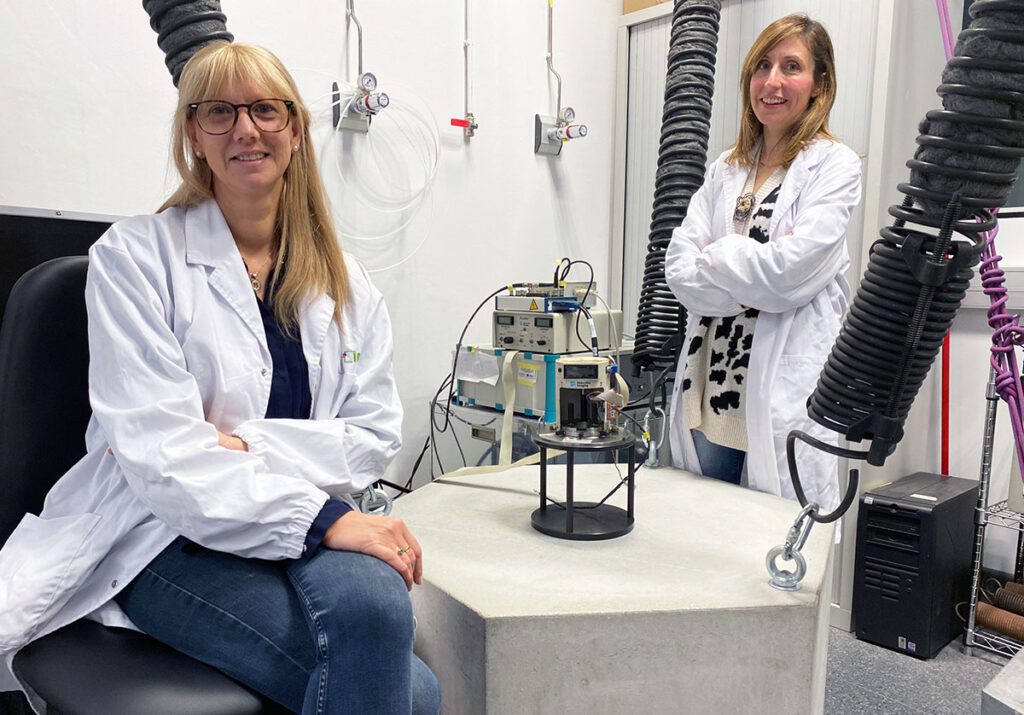Researchers at the Institute for Bioengineering of Catalonia (IBEC) and the Biomedical Research Networking Center in Bioengineering, Biomaterials, and Nanomedicine (CIBER-BBN) have achieved a nanoscale view of the electron transfer taking place within mitochondria, allowing for a better understanding of the process that regulates cellular respiration. The work, led by IBEC researchers Anna Lagunas and Marina I. Giannotti, has been published in the scientific journal Nature Communications and opens new possibilities in the research of this important biological function.

Mitochondria, known as the powerhouses of cells due to their role in energy production, are membrane-bound cell organelles found in almost all eukaryotic cells (animals, plants, and fungi). Their main function in animal cells is to convert nutrients into chemical energy, stored in the form of adenosine triphosphate (ATP) molecules, through a process called cellular respiration, which includes a tightly regulated electron transport chain. In addition to this function, mitochondria are also responsible for other functions, such as inducing cell death in response to stress events. Dysfunction of mitochondria has been linked to a number of diseases, such as dementia and heart diseases.
A new study led by the Institute for Bioengineering of Catalonia (IBEC) has used cutting-edge nanoscopic techniques to obtain an unprecedented view of the regulation of electron transport between the proteins driving mitochondrial processes. This work has shown that phosphorylation, the process by which a phosphate group is added and that allows for the adjustment of protein function, also affects electron transport in the mitochondrial respiratory chain. Due to the important role played by this cellular organelle in both health and disease states, this study is key to understand the function of this structure at the molecular level.
The study, recently published in the journal Nature Communications, was carried out by Anna Lagunas, senior researcher in the Nanobioengineering group at IBEC led by Josep Samitier, and Marina I. Giannotti, senior researcher in the Nanoprobes and Nanoswitches group at IBEC led by Pau Gorostiza. Both are researchers at CIBER-BBN. This study has also contributions from IBEC researchers Alexandre M. J. Gomila, Laura Casas-Ferrer and Sthefany Ortiz-Tescari, as well as from the research teams of Professor Irene Diaz-Moreno of the Institute of Chemical Research (IIQ-cicCartuja, Universidad de Sevilla – CSIC) and Professor Carme Rovira of the Institute of Theoretical and Computational Chemistry at the University of Barcelona.
Regulation of electron transport
Cellular respiration is the process by which cells convert nutrients into chemical energy and release waste products. This process takes place through a series of biochemical reactions, some of which are redox reactions involving the transfer of electrons between proteins. In mitochondria, cytochrome c and cytochrome bc1 are two of the proteins involved in this process. A previous study conducted by Anna Lagunas and led by Pau Gorostiza at IBEC demonstrated that these two proteins can transfer electrons a certain distance through a charge conduit established between them, implying that the formation of a tightly bound complex is not necessary, thus allowing for specificity to be maintained in a process that must be highly efficient. “In this new study, we wanted to better understand how phosphorylation regulates this process,” Giannotti comments.
This work combines the analysis of electron transport at the molecular level with the measurement of protein-protein interaction forces, allowing researchers to better understand the effects of cytochrome c phosphorylation on the molecular regulation of the mitochondrial respiratory chain. It was discovered that phosphorylation alters electron transport by disrupting the charge conduit and increasing the affinity between cytochrome c and cytochrome c1, thus leading to the formation of bottlenecks in the process, and slowing the flow of electrons in the chain.
“Phosphorylation of cytochrome c plays a crucial role in the regulation of mitochondrial respiration and cellular metabolism in general,” explains Lagunas.
“We observed that due to phosphorylation, the charge conduit between cytochrome c and cytochrome c1 becomes impaired and that the interaction between the two proteins is reinforced departing for the binding/unbinding equilibrium under the conditions of the experiment. This alters the diffusion pathway of cytochrome c molecules, slowing the process and therefore affecting the flow of electrons in the respiratory chain, partially inhibiting the mitochondrial respiration.”
Although this study focused on two specific proteins, cytochrome c and cytochrome c1, the mechanism of regulation discovered could be applied to other proteins involved in electron transfer processes, as well as other biological functions and types of regulation through phosphorylation.
“This is the first study to measure both the strength of the interaction and the charge transport between these two isolated proteins; by combining both measures, we have achieved a nanoscale view of protein interaction in electron transport chains and their regulatory mechanisms,” Giannotti concludes.
Reference article:
Alexandre M. J. Gomila, Gonzalo Pérez-Mejías, Alba Nin-Hill, Alejandra Guerra-Castellano, Laura Casas-Ferrer, Sthefany Ortiz-Tescari, Antonio Díaz-Quintana, Josep Samitier, Carme Rovira, Miguel A. De la Rosa, Irene Díaz-Moreno, Pau Gorostiza, Marina I. Giannotti & Anna Lagunas. Phosphorylation disrupts long-distance electron transport in cytochrome c. Nature Communications, volume 13, Article number: 7100 (2022)





